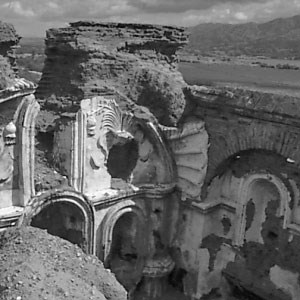
By Ginny Sphar
Father Joseph Matías was born in the village of Almarza, Spain, north of Soria. He considered himself a native of Logroño; his parents had moved there. On June 21, 1761, the 17-year-old Joseph entered the Franciscan Order. He was about 5’6”, pallid, pock-marked and very eager. He excelled in his studies and could have had a university career. Instead, when the appeal from recruiter Juan Domingo Arricivita reached the convento in Burgos, where Joseph was living, he joined the Mission of 1769. Moreno seemed almost obsessed with martyrdom.[1] Eight years later he would win his crown. The Yumas would cut off his head with an axe. The call for new methods in the missions generated more smoke than fire. The friars in the field blamed their troubles on the Apaches, ineffective military, epidemics, plagues of low-life traders and vagabonds, lack of financial support, not the old system. Some of Father Reyes’ fellow missionaries accused him of deceiving the fiscal and the Viceroy. It was not true, for example, that the Indians of Pimería Alta were still living wild and insubordinate in the native rancherías.[2] The Governors and Captains responded with diverse views. Some evaded the issue, instead making bland statements like settling the natives in formal pueblos with streets, teaching them law and order and instilling love of country.[3] A few, like Captain Bernardo de Urea of Altar, had the courage to praise the friars and their methods.[4] Others attacked the mission system head on, but none more vehemently than Juan Bautista de Anza.[5] Anza, baptized, taught and married by Jesuits and a lay affiliate of the Franciscans had observed missions and missionaries all his life. Why did he damn the system with such gusto? Perhaps he agreed with the Reformers; perhaps he had more faith in the Indians than did the missionaries. More than likely he resented the friars hold over such a large part of the frontier labor force. Whatever his motives, the able and ambitious career officer saw an opportunity to ingratiate himself at court. Two months earlier Fiscal Areche had recommended Anza’s proposed overland trek to California.[6] The Captain at Tubac was repaying the favor. On Saturday, January 8, 1774, a mass was held and Anza left on the trek to California. Father Moreno took part in the mass at the Tubac church. In June 1774, Father President Ramos came on an inspection tour to Tumacácori. They knew he was coming. Ramos’ companion must have sickened at Cocóspera so Ramos deputized Moreno. Ramos formally ordered Father Clemente to comply with five demands.[7] With Moreno as witness, Clemente bound himself to do so. Father Visitor must have noticed most of the refugees were camped at Calabazas. The people from Guevavi and Sonoita had separate rancherías, each with its own officials. Evidently they hoped to return home one day.[8] When he was satisfied at Tumacácori, Father Visitor Ramos left for San Xavier del Bac along with Father Moreno and an escort. A week later they were back. Fathers Clemente and Moreno stayed at Tumacácori through the year of 1774 and made do on the single 350-peso stipend. By early 1775, both had left Tumacácori. Moreno, listed as accidentado at one stage, stayed in the missions.[9] He labored at Caborca, and with Father Pedro Font, built the stocky, vaulted church at San Diego de Pitiquito.[10] In 1780 he joined Father Juan Díaz on the Río Colorado. Less than a year later, he, Díaz and Garcés and a fourth friar died in the Yuma massacre. Someone had chopped off Moreno’s head with an axe on the initial onslaught by the Yumas. [1] The baptismal and marriage records, complete for Moreno’s tenure at Tumacácori, show his first entry October 17, 1773, and his last December 22, 1774. DCB. Arricivita, Lista, 1769. Moreno to his sister, Madrid, March 26, 1769, CC, 202.14; quoted in large part by Arricivita, Crónica seráfica, pp. 536-40. [2] Father Joseph Soler to Cartagena, Pitiquito, August 12, 1773, CC, 201.28. [3] The governor of New Mexico reported briefly on the state of the missions in his province, mildly rebuked the friars for their ignorance of the Indian languages and their poor record teaching Spanish, and pointed out the need for more missionaries. Pedro Fermín de Mendinueta to Bucareli, Santa Fe, January 8, 1773, AGN, PI, 152; translated by Marc Simmons as Indian and Mission Affairs in New Mexico, 1773. [4] Urea to Bucareli, Altar, December 9, 1772, AGN, PI, 152. [5] Anza to Bucareli, Tubac, December 15, 1772, ibid.; Kessell, ed., “Anza Damns the Missions: A Spanish Soldier’s Criticism of Indian Policy, 1772,” JAH, Vol. 13 (1972), pp. 53-63. [6] Areche to Bucareli, Mexico, October 12, 1772, ACE, Vol. 5, pp. 12-24. [7] Ramos, Tubutama, April 13, 1774; visita of Pimería Alta, April 28-June 8, 1774, AGN, Californias, 39. Luis Baldonado O.F.M., translated portions of another copy as “Missions San José de Tumacácori and San Xavier del Bac in 1774,” The Kiva, Vol. 24 (1959), No. 4, pp. 21-24. [8] From entries in the Tumacácori register it would appear that Father Moreno had been living at least part of the time at Calabazas. DCB. Father Roche of Cocóspera had told the Father Visitor how fervently the people of Soamca wanted to go back to their gutted pueblo even after six years’ absence. [9] Clemente’s final extant entry in the Tumacácori register, a marriage is dated January 23, 1775; Moreno’s, a baptism, December 22, 1774. DCB Lists of personnel, ACQ, M. [10] Father Francisco Moyano, Noticias de las misiones que ocupan los religiosos del colegio de la Santa Cruz de Querétaro, Oquitoa, May 18, 1803, AGI, Mex., 2736. |
Last updated: May 6, 2025
